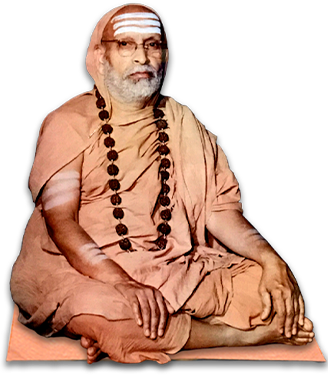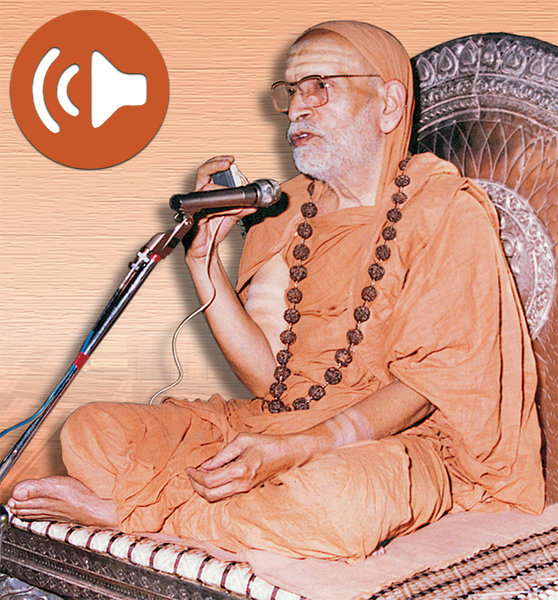His Holiness Sri Abhinava Vidyatheertha Mahaswamiji, the 35th Pontiff of Dakshinamnaya Sringeri Sri Sharada Peetham, was a multifaceted Jivanmukta, one liberated even when alive. His pre-monastic name was Sri Srinivasa. Born on 13 November, 1917, deepavali, the day of celebrations, of light dispelling darkness, He would go on to compassionately dispel the darkness of countless hearts. Sri Srinivasa studied till the eighth grade in Bengaluru. Barely twelve, He was ardently pious, exceptionally wise and farsighted, and yearned to renounce the world and realise God. Post His upanayana – investiture with the sacred thread including initiation into the Gayatri-mantra – in Sringeri on the 4 May, 1930, He stayed back in Sringeri to study the veda and Sanskrit. The then Jagadguru of Sri Sharada Peetham, Sri Chandrasekhara Bharati Mahaswamiji bestowed Him with samnyasa on 22 May, 1931, gave Him the monastic name Abhinava Vidyatheertha and made Him His successor-designate to the Peetham. Lord Shiva appeared in the young ascetic’s dream for six succeeding nights and taught Him pranayama, hatha-yoga and nadanusandhana. When the guru initiated Him into the sacred Narasimha-mantra, He was surprised to behold the form of Lord Narasimha in the place of His disciple. In a vision, His Holiness received instructions from Goddess Sharada on Kundalini-yoga. His Holiness promptly commenced the practice of karma-yoga. Next, His guru initiated him into contemplation on the Atman, the Self. Subsequently, His Holiness commenced deep meditation on divine forms – Shiva, Bala and Krishna, etc. Months before He had completed eighteen, He experienced his first savikalpa-samadhi. Having received, from Lord Shiva, a directive to focus on Brahman sans attributes, He soon attained savikalpa-samadhi and nirvikalpa-samadhi – the acme of Yoga – on Brahman in quick succession. In culmination of His spiritual practices, He attained the direct realization of and establishment in Brahman, and jivanmukti on 12th December 1935, just a few days after He had completed eighteen. Incredulous as it may seem, only thereafter did His guru expound Bhagavatpada’s bhashyas on Bhagavad-gita, upanishads and Brahma-sutras. These lessons served only to confirm what He had directly realised by then. He went on to become an unparalleled master in tarka and vedanta sastras and taught them to multiple batches of students. After His guru’s videha-mukti in September, 1954, He was coronated as the 35th pontiff of Sringeri Sri Sharada Peetham on 16 October, 1954. During his pontificate of 35 years, He undertook 35 tours, long and short, for over 17 years, touching cities, towns and even remote villages pan India. After Adi Shankara, He was the first Jagadguru Shankaracharya to have visited Nepal. A polyglot conversant with Hindi, Kannada, Tamil, Telugu and Sanskrit, He reached out to millions through His lucid discourses, exhorting them to follow Sanatana Dharma and imparting to them the knowledge of advaita, the Truth enshrined in the upanishads. He invariably accorded top priority to spiritual aspirants and often went out of His way to guide and bless them. He was instrumental in the establishment of Math branches, renovation and consecration of temples, setting up of veda and sastra pathashalas, construction of guest houses for devotees and pilgrims, institution of several religious, educational and cultural centres, etc. To cater to the medical needs of people in and around Sringeri, His Holiness started Sri Sharada Dhanvantari Charitable Hospital. Veda-Poshaka-Sabha to promote vedic learning and Sura-sarasvati-sabha to promote Sanskrit were His initiatives. His Holiness was instrumental in the first ever historic summit meet, since the days of Adi Shankara, of the Jagadguru Shankaracharyas of the four – Sringeri, Puri, Dvaraka and Badri – Amnaya Peethas at Sringeri on 1 May, 1979. He was freely accessible to common folk. Royals, Presidents, Prime Ministers, Governors, Ministers of the Central and State Governments, social leaders, scholars, scientists, artists and many others, besides leaders and representatives of different faiths and religions, had his darshan, blessings and guidance. He initiated His disciple Sri Sitarama Anjaneyulu into samnyasa on 11 November, 1974 and made him His successor-designate to the peetham. His Holiness shed His mortal coil on 21 September, 1989 at Sringeri. Sri Abhinava Vidyatheertha Mahaswamiji was firmly established in Brahman, was innately full of compassion, had a deep understanding of people and was competent to confer unfailing blessings. He was well and truly a consummate Guru. His Holiness


